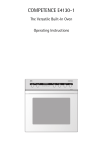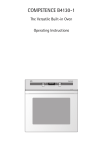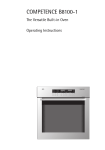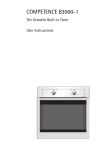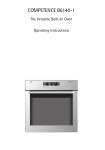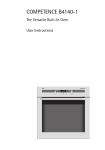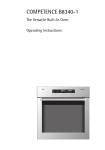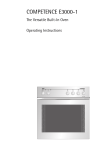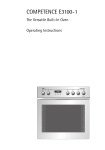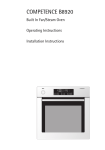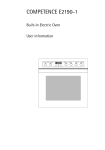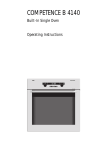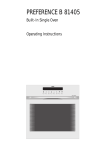Download Electrolux B8140-1 User's Manual
Transcript
COMPETENCE B8140-1 The Versatile Built-in Oven Operating Instructions Dear customer, Please read these operating instructions carefully. Pay particular attention to the section “Safety information” on the first few pages. Please retain these operating instructions for later reference. Pass them on to possible new owners of the appliance. The following symbols are used in the text: 1 Safety instructions Warning: Information concerning your personal safety. Important: Information on how to avoid damaging the appliance. 3 Information and practical tips 2 Environmental information 1. These numbers indicate step by step how to use the appliance. 2. ... 3. ... In the event of any technical problems please contact your nearest CUSTOMER SERVICE CENTRE at any time. (Addresses and telephone numbers may be found in the appendix under "Customer Service Centres“). You should also refer to the section "Service"“. Printed on environmentally friendly paper. Thinking ecologically means acting ecologically ... 2 Contents Safety . . . . . . . . . . . . . . . . . . . . . . . . . . . . . . . . . . . . . . . . . . . . . . . . . . . . . . . . 5 Disposal . . . . . . . . . . . . . . . . . . . . . . . . . . . . . . . . . . . . . . . . . . . . . . . . . . . . . . 7 Description of the Appliance . . . . . . . . . . . . . . . . . . . . . . . . . . . . . . . . . . . . 8 General Overview . . . . . . . . . . . . . . . . . . . . . . . . . . . . . . . . . . . . . . . . . . . . . . . 8 Control Panel . . . . . . . . . . . . . . . . . . . . . . . . . . . . . . . . . . . . . . . . . . . . . . . . . . 9 Oven Features . . . . . . . . . . . . . . . . . . . . . . . . . . . . . . . . . . . . . . . . . . . . . . . . . . 10 Oven accessories . . . . . . . . . . . . . . . . . . . . . . . . . . . . . . . . . . . . . . . . . . . . . . . 11 Before Using for the First Time . . . . . . . . . . . . . . . . . . . . . . . . . . . . . . . . . 12 Setting the Time . . . . . . . . . . . . . . . . . . . . . . . . . . . . . . . . . . . . . . . . . . . . . . . 12 Initial Cleaning . . . . . . . . . . . . . . . . . . . . . . . . . . . . . . . . . . . . . . . . . . . . . . . . . 13 Using the Oven . . . . . . . . . . . . . . . . . . . . . . . . . . . . . . . . . . . . . . . . . . . . . . . . The Electronic Oven Control . . . . . . . . . . . . . . . . . . . . . . . . . . . . . . . . . . . . . . Oven Functions . . . . . . . . . . . . . . . . . . . . . . . . . . . . . . . . . . . . . . . . . . . . . . . . Inserting the Shelf and Universal Baking Tray . . . . . . . . . . . . . . . . . . . . . . . Inserting/Removing the Fat Filter . . . . . . . . . . . . . . . . . . . . . . . . . . . . . . . . . Additional Functions . . . . . . . . . . . . . . . . . . . . . . . . . . . . . . . . . . . . . . . . . . . . Clock Functions . . . . . . . . . . . . . . . . . . . . . . . . . . . . . . . . . . . . . . . . . . . . . . . . Other Functions . . . . . . . . . . . . . . . . . . . . . . . . . . . . . . . . . . . . . . . . . . . . . . . . Oven Child Safety Feature . . . . . . . . . . . . . . . . . . . . . . . . . . . . . . . . . . . . . Button Locking Feature . . . . . . . . . . . . . . . . . . . . . . . . . . . . . . . . . . . . . . . Oven safety cut-out . . . . . . . . . . . . . . . . . . . . . . . . . . . . . . . . . . . . . . . . . . 14 14 15 19 20 21 26 32 33 34 35 Uses, Tables and Tips . . . . . . . . . . . . . . . . . . . . . . . . . . . . . . . . . . . . . . . . . . . Baking . . . . . . . . . . . . . . . . . . . . . . . . . . . . . . . . . . . . . . . . . . . . . . . . . . . . . . . . Baking Table . . . . . . . . . . . . . . . . . . . . . . . . . . . . . . . . . . . . . . . . . . . . . . . . Pies and Gratin Table . . . . . . . . . . . . . . . . . . . . . . . . . . . . . . . . . . . . . . . . . Frozen Ready Meals Table . . . . . . . . . . . . . . . . . . . . . . . . . . . . . . . . . . . . . Roasting . . . . . . . . . . . . . . . . . . . . . . . . . . . . . . . . . . . . . . . . . . . . . . . . . . . . . . Roasting Table . . . . . . . . . . . . . . . . . . . . . . . . . . . . . . . . . . . . . . . . . . . . . . Meat Probe Table . . . . . . . . . . . . . . . . . . . . . . . . . . . . . . . . . . . . . . . . . . . . Grilling . . . . . . . . . . . . . . . . . . . . . . . . . . . . . . . . . . . . . . . . . . . . . . . . . . . . . . . Grilling Table . . . . . . . . . . . . . . . . . . . . . . . . . . . . . . . . . . . . . . . . . . . . . . . 36 36 38 42 43 44 46 48 49 49 3 Bio-Functions . . . . . . . . . . . . . . . . . . . . . . . . . . . . . . . . . . . . . . . . . . . . . . . . . . Low Temperature Roasting Table . . . . . . . . . . . . . . . . . . . . . . . . . . . . . . . Making Yoghurt . . . . . . . . . . . . . . . . . . . . . . . . . . . . . . . . . . . . . . . . . . . . . Proving Dough . . . . . . . . . . . . . . . . . . . . . . . . . . . . . . . . . . . . . . . . . . . . . . Drying . . . . . . . . . . . . . . . . . . . . . . . . . . . . . . . . . . . . . . . . . . . . . . . . . . . . . Defrosting . . . . . . . . . . . . . . . . . . . . . . . . . . . . . . . . . . . . . . . . . . . . . . . . . . . . . Defrosting Table . . . . . . . . . . . . . . . . . . . . . . . . . . . . . . . . . . . . . . . . . . . . . Preserving . . . . . . . . . . . . . . . . . . . . . . . . . . . . . . . . . . . . . . . . . . . . . . . . . . . . . 50 52 53 53 54 55 55 56 Cleaning and Care . . . . . . . . . . . . . . . . . . . . . . . . . . . . . . . . . . . . . . . . . . . . . Exterior of the Appliance . . . . . . . . . . . . . . . . . . . . . . . . . . . . . . . . . . . . . . . . Oven Interior . . . . . . . . . . . . . . . . . . . . . . . . . . . . . . . . . . . . . . . . . . . . . . . . . . Accessories . . . . . . . . . . . . . . . . . . . . . . . . . . . . . . . . . . . . . . . . . . . . . . . . . . . . Fat Filter . . . . . . . . . . . . . . . . . . . . . . . . . . . . . . . . . . . . . . . . . . . . . . . . . . . . . . Cleaning with Pyroluxe . . . . . . . . . . . . . . . . . . . . . . . . . . . . . . . . . . . . . . . . . . Shelf Support Rails . . . . . . . . . . . . . . . . . . . . . . . . . . . . . . . . . . . . . . . . . . . . . Oven Lighting . . . . . . . . . . . . . . . . . . . . . . . . . . . . . . . . . . . . . . . . . . . . . . . . . Oven Door . . . . . . . . . . . . . . . . . . . . . . . . . . . . . . . . . . . . . . . . . . . . . . . . . . . . . Oven door glass . . . . . . . . . . . . . . . . . . . . . . . . . . . . . . . . . . . . . . . . . . . . . . . . 58 58 58 58 58 59 61 63 64 65 What to do if ... . . . . . . . . . . . . . . . . . . . . . . . . . . . . . . . . . . . . . . . . . . . . . . . 67 Technical Data . . . . . . . . . . . . . . . . . . . . . . . . . . . . . . . . . . . . . . . . . . . . . . . . 69 Oven Interior Dimensions . . . . . . . . . . . . . . . . . . . . . . . . . . . . . . . . . . . . . . . . 69 Regulations, Standards, Directives . . . . . . . . . . . . . . . . . . . . . . . . . . . . . . . . . 69 Index . . . . . . . . . . . . . . . . . . . . . . . . . . . . . . . . . . . . . . . . . . . . . . . . . . . . . . . . . 70 Service . . . . . . . . . . . . . . . . . . . . . . . . . . . . . . . . . . . . . . . . . . . . . . . . . . . . . . . 71 4 1 Safety Electrical Safety • The appliance may only be connected by a registered specialist. • In the event of any faults or damage to the appliance: remove fuses or switch off. • It is not permissible to clean the appliance with a steam or high pressure cleaner for safety reasons! • Repairs to the appliance may only be carried out by specialists. Repairs carried out by inexperienced persons may cause injury or serious malfunctioning. If your appliance needs repairing, please contact your local AEG Service Force Centre or your specialist dealer. Child Safety • Never leave children unsupervised when the appliance is in use. Safety whilst Using • This appliance is intended to be used for cooking, frying and baking food in the home. • Take care when connecting electric appliances to sockets nearby. Do not allow connecting leads to come into contact with hot rings or to catch beneath the hot oven door. • Warning: Risk of burns! The interior of the oven becomes hot during use. • Using ingredients containing alcohol in the oven may create an alcohol-air mixture that is easily ignited. In this case, open the door carefully. Do not have embers, sparks or naked flames in the vicinity when opening the door. 5 To Avoid Damaging Your Appliance • Do not line your oven with aluminium foil and do not place a baking tray or dish on the oven floor, otherwise the oven enamel will be damaged by the resulting build up of heat. • Juice from fruit that drips from baking trays will leave marks that cannot be removed. For very moist cakes, use the universal baking tray. • Do not put any weight on the oven door when it is open. • Never pour water directly into the hot oven. The enamel may be damaged. • Using force, especially on the edges of the front glass panel, may break the glass. • Do not store inflammable objects in the oven. They may ignite when the oven is switched on. • Do not store moist food in the oven. The enamel may be damaged. 6 2 Disposal Disposing of the packaging material All materials used can be fully recycled. Plastics are marked as follows: • >PE< for polyethylene, as used for the outer wrapping and the bags inside. • >PS< for polystyrene foam, e.g., as used for the padding materials. They are completely free of CFCs. Disposal of old appliances 1 Warning: Before disposing of old appliances please make them inoperable so that they cannot be the source of danger. To do this, disconnect the appliance from the mains supply and remove the mains lead. To protect the environment, it is important that worn out appliances are disposed of in the correct manner. • The appliance must not be disposed of with household rubbish. • You can obtain information about collection dates or public refuse disposal sites from your local refuse department or council. 7 Description of the Appliance General Overview 8 Control Panel Mains button For switching the entire appliance on and off. Mains button on appliances with a metal front 3 In the following text and in the illustrations the symbol N is always used to indicate the mains button. 9 Oven Features Oven steam vent Steam from the oven is fed out below the door handle. Relates only to appliances with a metal front: Steam from the oven is fed out between the upper door edge and the control panel. 10 Oven accessories Combination shelf For dishes, cake tins, items for roasting and grilling. Baking tray For cakes and biscuits Fat tray For roasting or for collecting fat. Meat probe For determining exactly how far joints of meat are cooked. 11 Before Using for the First Time Setting the Time 3 The oven will only operate when the time has been set. After connection to the mains or following a power failure “12.00” is illuminated and “TIME” flashes. 1. Using buttons + or - set the current time. 2. Wait for approx. 5 seconds. The flashing will stop and the set time is displayed. The appliance is ready for use. 12 Initial Cleaning Before using the oven for the first time you should clean it thoroughly. 1 Important: Do not use any caustic, abrasive cleaners! The surface could be damaged. 3 Tip: Use commercially available cleaners for metal fronts. Switch on the appliance using the mains button. The symbol above the button will be illuminated. 3. Press selection button X once for oven functions. “LIGHT” is illuminated and the oven lighting is switched on. 4. Remove all accessories and the shelf support rails and wash them with warm water and washing up liquid. 5. Then wash out the oven with warm water and washing-up liquid, and dry. 6. Wipe the front of the appliance with a damp cloth. 7. After cleaning switch off the oven lighting using selection button Y for oven functions. 13 Using the Oven The Electronic Oven Control 3 14 General information • Always switch the appliance on first using the mains button N. • When the selected function is illuminated the oven starts to heat up and the set time begins to count down. • The oven lighting comes on as soon as an oven function is selected. • Switch the appliance off using the mains button N. Oven Functions The oven has the following functions: 3 The BAKING, CONVENTIONAL and ROTITHERM functions include an automatic fast warm up. This ensures that the selected temperature is reached as quickly as possible. BAKING Suggested temperature: 150 °C For baking cakes on one level and for pastries that need more browning and a crispy base. These include such foods as pizza, quiche lorraine, and cheese cake. Set oven temperatures 20-40 °C lower than when using conventional. Conventional is used and in addition the fan is switched on. FAN COOKING Suggested temperature: 150 °C For baking on up to three levels at the same time. Set oven temperatures 20-40 °C lower than when using conventional. The rear wall heating element is used and in addition the fan is switched on. CONVENTIONAL Suggested temperature: 200 °C For baking and roasting on one level. The top and bottom heating elements are in use. ROTITHERM Suggested temperature: 180 °C For roasting larger pieces of meat or poultry on one level. This function is also suited to cooking foods au gratin and browning. The grill heating element and top heat operate alternately with the fan. 15 DUAL GRILL Suggested temperature: 300 °C For grilling larger quantities of flat foods such as steaks, escalopes or fish, or for toasting. Top heat and the grill heating element are in use. SINGLE GRILL Suggested temperature: 300 °C For grilling flat foods placed on the middle of the shelf such as steaks, escalopes or fish, or for toasting. The grill heating element is in use. KEEPING FOOD WARM Temperature setting: 80 °C To keep food warm. The top and bottom heating elements are in use. DEFROST Temperature setting: 30 °C To begin to thaw and to defrost such items as flan, butter, bread, fruit or other frozen foods. For this function the fan operates without heating. BOTTOM HEAT Suggested temperature: 150 °C For crisping and browning cakes with crispy bases. The bottom heating element is in use. LIGHT To switch the oven lighting on and off. The oven lighting is switched on automatically as long as the oven is in operation. 16 Switching On Oven Functions 1. Switch the appliance on with the mains button N. 2. Press selection button X or Y until the required function is illuminated. A suggested temperature will appear in the temperature display. The temperature pilot light comes on while the oven is heating up. Changing the Oven Temperature Press the + or - button to increase or decrease the temperature. The temperature may be set at intervals of 5 °C. Changing the Oven Function Press the X or Y button repeatedly until the required function is illuminated. 17 Switching the Oven Off To switch the oven off press selection button X or Y repeatedly until none of the oven functions is illuminated. 3 Cooling fan The fan comes on automatically when the oven is in use in order to keep the surfaces of the appliance cool. Once the oven has been switched off, the fan continues running to cool down the appliance and then switches itself off automatically. Switching the Oven Lighting On and Off You can also switch on the oven lighting without an oven function. 1. Switch the appliance on using the mains button N. 2. Press selection button X once for oven functions. “LIGHT” is illuminated and the oven lighting is switched on. 3. Press selection button Y once for oven functions. The oven lighting is switched off. 18 Inserting the Shelf and Universal Baking Tray 3 Anti-tip device All slide-in units have a small bulge on the left and right. This bulge is an anti-tip device and must always point to the rear of the oven. Tray or universal baking tray: The anti-tip device must point towards the rear of the oven. ✘ Inserting shelf: Insert the shelf unit with both guide rails pointing upwards. The anti-tip device must point downwards and be positioned to the rear of the oven compartment. Inserting shelf and tray: When the shelf unit and universal baking tray are used together, carefully place the shelf anti-tip device in the bulges on the tray. 19 Inserting/Removing the Fat Filter The fat filter protects the rear wall heating element against splashes of fat when roasting. Inserting the fat filter Holding the fat filter by the tab, insert the two retainers into the opening on the rear wall of the oven (fan opening) from the top downwards. Removing the fat filter Take hold of the tab on the fat filter and remove by pulling upwards. 20 Additional Functions PIZZA To bake ready meals such as pizza, lasagne, foods au gratin and chips from the freezer. There is no need to pre-heat the oven as recommended on the packaging when this special additional function is used. 3 Refer to the maker's instructions for preparation. Use the oven temperature for hot air. 1. Press additional functions selection button Y repeatedly until the “PIZZA” function is illuminated. The suggested temperature of “200 °C” will appear in the temperature display. 2. By pressing the relevant + or button the suggested temperature can be increased or decreased in stages of 10 °C. 3 Turn chips etc. 2 - 3 times during cooking. 21 CAKES For baking prepared cakes and cake mixtures. There is no need to preheat the oven as recommended on the packaging when this special additional function is used. 3 Refer to the maker's instructions for preparation. Use the oven temperature for hot air. 1. Press additional functions selection button Y repeatedly until the “CAKES” function is illuminated. The suggested temperature of “160 °C” will appear in the temperature display. 2. By pressing the relevant + or button the suggested temperature can be increased or decreased in stages of 10 °C. 22 POULTRY To roast whole poultry on an automatic program where all you need to do is set the weight. 1. Prepare the poultry for roasting then place it breast down in the roasting dish and insert it on the shelf in the first oven position from the bottom. 2. Press additional functions selection button Y repeatedly until “POULTRY” is illuminated. “1.3” will appear in the temperature display and the “COOK TIME” clock function will be illuminated. 3. Press the relevant + or - buttons within the next minute to change the weight setting (0.5 - 2.9). 3 You can check the COOK TIME by pressing clock functions selection button Y. 4. After approx. 2/3 of the roasting time an acoustic signal will sound to remind you to turn the poultry. 5. At the end of the cooking time an acoustic signal will sound. The oven will switch off. PYROLUXE For pyrolytic self-cleaning. During this process splashes and deposits are burned in the oven and can be washed off once the oven has cooled. The oven is heated to approx. 500 °C. See “Cleaning with Pyroluxe” . 23 Meat Probe To switch the oven off when the precise meat core temperature has been reached. 1 Important: Only the meat probe delivered with the oven should be used! If a replacement is required use only an original spare part. 1. Push the tip of the meat probe as far as possible into the food that is to be cooked so that the tip is right in the centre of the food. 2. Push the meat probe plug fully into the socket on the side wall of the oven. “MEAT PROBE” is illuminated. 3. Set the required oven function and oven temperature. The suggested temperature for the selected oven function will appear in the temperature display on the left. In the time display on the right a suggested temperature of '60 C' will appear for the meat core temperature. 4. Set the required meat core temperature using time selection buttons + or -. 24 After approx. 5 seconds the current meat core temperature will be shown in the time display on the right. 3 The meat core temperature is displayed from 30 °C upwards. 3 Checking or changing the meat core temperature – The set meat core temperature can be displayed by pressing buttons + or - once. – It is possible to change a previously selected temperature by pressing + or - several times. As soon as the measured meat core temperature matches the temperature that has been set an acoustic signal will sound and the oven will switch off automatically. 5. Press the + or - time selection button to deactivate the signal. Warning: The meat probe is hot! There is a risk of burning when the plug and probe are removed! 6. Pull the meat probe plug out of the socket and remove the cooked food from the oven with the meat thermometer still inside it. 7. Switch off the oven. 1 25 Clock Functions COUNTDOWN To set a countdown. A signal sounds after the time has elapsed. This function does not affect the functioning of the oven. COOK TIME To set how long the oven is to be in use. END TIME To set when the oven is to switch off again. TIME To set, change or check the time. (See also section “Before Using for the First Time”.) 3 26 General information • Before setting the time always switch the appliance on using the mains button N. • After a clock function has been selected the function will flash for approx. 5 seconds. During this time the required times can be set or changed using the + or - time selection buttons. • After the required time has been set the function will flash again for approx. 5 seconds. Then the function stays illuminated. The set time will begin to count down. • The acoustic signal may be turned off by pressing any clock button. COUNTDOWN 1. Press clock function selection button Y repeatedly until COUNTDOWN is flashing. 2. Using buttons + or - set the required countdown. (Max. 2 hours and 30 minutes.) After approx. 5 seconds the display will show the remaining time. COUNTDOWN is illuminated. When the time has expired COUNTDOWN flashes and an acoustic signal will sound for 2 minutes. To switch the acoustic signal off: press any clock functions button. 27 COOK TIME 1. Select oven function and temperature. 2. Press clock function selection button Y repeatedly until COOK TIME flashes. 3. Using buttons + or - set the required cooking time. After approx. 5 seconds the display will switch to the time. COOK TIME is illuminated. When the cooking time has expired COOK TIME will flash, an acoustic signal will sound for 2 minutes and the oven will switch off. To switch the acoustic signal off: press any clock function button. 28 END TIME 1. Select oven function and temperature. 2. Press clock function selection button Y repeatedly until END TIME is flashing. 3. Using the + button set the time at which you want the oven to switch off. After approx. 5 seconds the display will revert to the time. END TIME is illuminated. 4. When the time has expired END TIME will flash, an accoustic signal will sound for 2 minutes and the oven will switch off. To switch the acoustic signal off: press any clock function button. 29 COOK TIME and END TIME Combined 3 COOK TIME and END TIME can be used together if the oven is to switch on and off automatically at a later time. 1. Select oven function and temperature. 2. Using the COOK TIME function set the time required for the dish to cook. E.g. 1 hour. 3. Using the END TIME function set the time at which the dish is to be ready. E.g., 14:05. 4. COOK TIME and END TIME are illuminated and the time will appear in the display. In this case 12:05. The oven will switch on automatically at the calculated time. E.g., 13:05. 5. After the set period of time has expired an acoustic tone will sound for 2 minutes and the oven will switch off. E.g., 14:05. COOK TIME and END TIME will flash. 30 Changing TIME 1. Press clock function selection button Y repeatedly until TIME flashes. 2. Using buttons + or - set the current time. 3. After approx. 5 seconds the flashing will stop and the clock will display the set time. The appliance is ready for use again. 3 The TIME can only be changed if the oven and child safety feature are switched off. 31 Other Functions 2 Switching Off the Time Display By switching off the time display you can save energy. Switching off the time display 1. If necessary switch off the appliance with the mains button. 2. Press clock functions Y and + simultaneously until the display goes dark (approx. 5 seconds). 3 As soon as the appliance is used again the display will automatically switch on. The next time the appliance is switched off the time display will again go out. To display the time constantly again the time display must be switched on again. Switching on the time display 1. If necessary switch off the appliance with the mains button. 2. Press clock functions selection buttons Y and + simultaneously until the display reappears (approx. 5 seconds). 3 32 The display can only be switched off if the oven is also switched off. Oven Child Safety Feature The oven is equipped with a child safety feature. As soon as the child safety feature is activated, the oven cannot be used. 3 There must be no oven function selected if the child safety feature is to be switched on. Activating the Child Safety Feature 1. If necessary, switch on the appliance using the mains button. 2. Hold down oven function selector buttons X and Y simultaneously until “SAFE” appears in the oven display. The child safety feature is now activated. Deactivating the Child Safety Feature Hold down oven function selector buttons X and Y simultaneously for approx. 2 seconds. The child safety feature is now deactivated and the oven is again ready for use. 3 Switching off the appliance with the mains button does not cancel the child safety feature. 33 Button Locking Feature To prevent a set oven function being adjusted unintentionally. Activating the button locking feature 1. If necessary, switch on the appliance using the mains button. 2. Select oven function. 3. Hold down oven function selector buttons X and Y simultaneously for approx. 2 seconds until “LO” appears in the display. The button locking feature has now been activated. Deactivating the button locking feature Hold down oven function selector buttons X and Y simultaneously for approx. 2 seconds. The button locking feature is automatically deactivated when the appliance is switched off. 34 Oven safety cut-out 3 If not switched off after a certain time, or if the temperature does not change, the oven switches off automatically. The indication "0.00" flashes, the temperature indicator light flashes, and a signal sounds. The oven switches off at temperatures of: 30 - 120° C 120 - 200° C 200 - 250° C 250 - 300° C after after after after 12.5 hours 8.5 hours 5.5 hours 1.5 hours Switching on again after a safety cut-out Switch the oven off completely. You will then be able to switch on again. 35 Uses, Tables and Tips Baking Use the BAKING, FAN COOKING or CONVENTIONAL oven functions for baking. Baking tins • Cake tins made of dark metal and coated tins are suitable for CONVENTIONAL. • Baking tins made of light metal are also suitable for BAKING and FAN COOKING. Shelf positions • Baking with BAKING or CONVENTIONAL is only possible on one shelf position at a time. • With FAN COOKING you can bake on up to three baking trays at once: 36 1 Baking tray e.g., shelf position 3 1 Baking tin: e.g., shelf position 1 2 Baking trays: Shelf positions 1 and 4 3 Baking trays: Shelf positions 1, 3 and 5 3 General information • Remove the fat filter when baking, as otherwise the baking time is longer and the surface will brown unevenly. • Always count the shelf positions from the bottom upwards. • Insert baking sheets with the bevelled edge to the front! • Always place cake tins in the middle of the shelf. • With BAKING or CONVENTIONAL you can also bake with two tins at the same time by placing them side by side on the shelf. There is no significant increase in baking time. Notes on the baking tables In the tables you will find information on temperatures, cooking times and shelf positions for a selection of dishes. • The temperatures and cooking times are for guidance only since these are dependent on the mixture, quantity and cake tin used. • When using for the first time, we recommend setting the lower temperature, and only if necessary, e.g. if increased browning is required or the cooking time is too long, select a higher temperature. • If you cannot find specific information for one of your own recipes, use information given in a similar recipe for guidance. • When cakes are baked on trays or in tins on more than one oven position at once the baking time may be increased by 10-15 minutes. • Items that might drip (e.g., pizzas, fruit flans) should only be prepared on one level. • Variations in the height of the item to be baked can lead to different degrees of browning at the start of baking. In this case please do not change the temperature setting. Differences in the degree of browning will balance out during baking. 2 For longer cooking times switch off the oven approx. 10 minutes before the end of the cooking time to make use of the residual heat. Unless otherwise stated, the information in the tables assumes starting with a cold oven. 37 Baking Table Baking on one shelf position Type of cake or pastry BAKING CONVENTIONAL Time Shelf Tempera- Shelf po- Tempera- For both position ture sition ture functions from ºC from ºC Hrs.: Mins. bottom bottom Cakes in cake tins Ring-shaped or bowl-shaped cakes 1 150-160 1 160-180 0:50-1:10 Madeira cake/ king cake 1 140-160 1 150-170 1:10-1:30 Sponge cake 1 150-160 1 160-180 0:25-0:40 Shortcrust pastry flan base 3 170-180 2 190-2101 0:10-0:25 Sponge flan base 3 150-170 2 170-190 0:20-0:25 Covered apple flan 1 150-170 1 170-190 0:50-1:00 Savoury flan (e.g., quiche lorraine) 1 160-180 1 190-210 0:30-1:10 Cheesecake 1 140-160 1 170-190 1:00-1:30 Plaited roll/ring 3 160-170 3 170-190 0:30-0:40 Fruit loaf 3 150-1701 3 160-1801 0:40-1:00 Bread (rye bread) initially .....................................then 1 .180-2001 140-160 2 2501 160-180 0:20 0:30-1:00 Cream puffs/eclairs 3 160-1701 3 190-210 0:15-0:30 Swiss roll 3 150-1701 3 180-2001 0:10-0:20 Dry streusel cake 3 150-160 3 160-180 0:20-0:40 Butter cake/sugar cake 3 160-1701 3 190-2101 0:15-0:30 Cakes and pastries on baking trays 38 Type of cake or pastry BAKING CONVENTIONAL Time Shelf Tempera- Shelf po- Tempera- For both position ture sition ture functions from ºC from ºC Hrs.: Mins. bottom bottom Fruit flan (with a yeast dough/sponge base)2 3 150-170 3 170-190 0:25-0:50 Fruit flans on shortcrust pastry base1 3 160-170 3 170-190 0:40-1:20 Tarts with delicate fillings (e.g., curd cheese, cream, sugar-topped cakes) - - 3 160-1801 0:40-1:20 Pizza (with deep topping)2 1 180-200 1 190-2101 0:30-1:00 Pizza (thin) 1 200-220 1 230-3001 0:10-0:25 Unleavened bread 1 200-220 1 270-3001 0:08-0:15 Flat sweet or savoury pies 1 180-200 1 210-230 0:35-0:50 Shortcrust biscuits 3 150-160 3 170-1901 0:06-0:20 Small piped biscuits 3 140-150 3 160-180 0:10-0:40 Sponge fingers 3 150-160 3 170-190 0:15-0:20 Meringues 3 80-100 3 100-120 2:00-2:30 Macaroons 3 100-120 3 120-140 0:30-0:60 Small pastries made with yeast dough 3 160-170 3 170-190 0:20-0:40 Small pastries made with puff pastry 3 170-1801 3 190-2101 0:20-0:30 Bread rolls 3 180-2001 3 180-2201 0:20-0:35 Biscuits 1) Pre-heat the oven 2) Use the combination/fat tray or the fat tray! Information printed in bold type indicates the best oven function in each case. 39 Baking on several shelf positions FAN COOKING Type of cake or pastry Shelf position from bottom Temperature ºC Time Hours: Mins. 2 Levels 3 Levels Cream puffs/eclairs 1/4 - 160-1801 0:35-0:60 Dry streusel cake 1/4 - 140-160 0:30-0:60 Shortcrust biscuits 1/4 1/3/5 150-160 0:15-0:35 Small piped biscuits 1/4 1/3/5 140-150 0:20-0:60 Sponge fingers 1/4 - 160-170 0:25-0:40 Meringues 1/4 - 80-100 2:10-2:50 Macaroons 1/4 - 100-120 0:40-1:20 Small pastries made with yeast dough 1/4 - 160-170 0:30-0:60 Small pastries made with puff pastry 1/4 - 170-1801 0:30-0:50 Bread rolls 1/4 - 180-1901 0:30-0:55 Cakes and pastries on baking sheets Biscuits 40 Tips for Baking Baking result Possible cause The cake is underWrong shelf position cooked at the bottom The cake collapses (is sticky, soft in the middle, damp patches) Cake is too dry Cake is unevenly browned Cooking time too long Solution Insert the cake at a lower shelf position Cooking temperature too high Set to a lower temperature Cooking time too short Increase cooking time Cooking times may not be reduced by using a higher cooking temperature Too much liquid in mixture Next time use less liquid. Check that you have beaten the mixture for the correct length of time, particularly when using a food-processor. Cooking temperature too low Set a slightly higher baking temperature next time Cooking time too long Reduce cooking time Cooking temperature too high and cooking time too short Set to a lower temperature and increase cooking time Mixture is spread unevenly Spread mixture evenly on the baking tray Fat filter is still in position Remove fat filter Temperature too low Set a slightly higher baking temperature next time Fat filter is still in position Removing the fat filter 41 Pies and Gratin Table CONVENTIONAL ROTITHERM Time Shelf position from bottom Temperature °C Shelf position from bottom Temperature °C Hours: Mins. Pasta bake 1 180-200 1 160-170 0:45-1:00 Lasagne 1 180-200 1 160-170 0:25-0:40 Vegetables au gratin1 1 200-220 1 160-170 0:15-0:30 Pizza baguettes1 1 200-220 1 160-170 0:15-0:30 Sweet soufflés 1 180-200 - - 0:40-0:60 Fish pies 1 180-200 1 160-170 0:30-1:00 Stuffed vegetables 1 180-200 1 160-170 0:30-1:00 1) Pre-heat the oven. Information printed in bold type indicates the best oven function for the dish. 42 Frozen Ready Meals Table Food to be cooked Shelf position from bottom Frozen pizza 3 Chips1 (300-600 g) 3 Baguettes Fruit flan Oven function Temperature Time in accordance in accordance with the with the maker's CONVENTIONAL maker's instrucinstructions tions ROTITHERM 200-220 °C 15-25 Mins. 3 in accordance in accordance with the with the maker's CONVENTIONAL maker's instrucinstructions tions 3 in accordance in accordance with the with the maker's CONVENTIONAL maker's instrucinstructions tions 1) Comment: Turn chips 2-3 times during cooking. 3 When frozen foods are used the trays inserted may distort during cooking. This is because of the large differences in temperature between the frozen item and the oven. Once the trays have cooled the distortion will disappear again. 43 Roasting Use the ROTITHERM or CONVENTIONAL oven functions for roasting. Ovenware for roasting • Any heat-resistant dish is suitable for roasting (refer to the manufacturer's instructions!). • If the dish has plastic handles, check that they are heat-resistant (refer to manufacturer's instructions!). • Large roasts can be roasted directly on the universal baking tray or on the shelf with the universal baking tray underneath (e.g. turkey, goose, 3-4 chickens, 3-4 knuckles of veal). • We recommend that all lean pieces of meat should be roasted in a casserole dish with a lid (e.g. veal, marinated beef, pot roast, frozen meat.) In this way the meat will retain its juices. • In order to obtain a tasty outside crust we recommend roasting pieces of meat in a casserole dish without a lid (e.g. roast pork, lamb and mutton, meat loaf, duck, 1-2 knuckles of veal, 1-2 chickens, small fowl, roast beef, fillets, game). 3 Tip: The oven will be less dirty if you always use a dish for roasting! Shelf positions • Please see the following table for the shelf positions to be used. 44 3 Notes on the roasting table Information is given in the table on suitable oven functions, temperature settings, cooking times and shelf positions for various types of meat. The information is for guidance. • We recommend roasting meat and fish with a minimum weight of 1kg in the oven. • Generally the CONVENTIONAL function is particularly suitable for very lean meat such as fish or game. For all other types of meat (especially poultry) we recommend the ROTITHERM function. • To stop meat juices or fat burning onto dishes or the oven, we recommend adding a little liquid to the roasting dish. • Turn the joint as required (after 1/2 - 2/3 of the cooking time). 3 Tip: Baste large joints and poultry several times during cooking with the meat juices. This will produce better roasting results. 2 Switch off the oven approx. 10 minutes before the end of the cooking time to make use of the residual heat. 45 Roasting Table Type of meat Quantity CONVENTIONAL ROTITHERM Time Weight Shelf po- Temperasition ture from botºC tom Shelf Temperaposition ture from ºC bottom Hours: Mins. Beef Pot roast 1-1.5 kg 1 200-250 - - Roast beef or fillet 2:00-2:30 per cm of thickness - rare per cm of thickness 1 250-2701 1 190-200 0:05-0:06 - medium rare per cm of thickness 1 250-2701 1 180-190 0:06-0:08 - well done per cm of thickness 1 210-2501 1 170-180 0:08-0:10 Shoulder, neck ham joint 1-1.5 kg 1 210-220 1 160-180 1:30-2:00 Chop, smoked loin chop 1-1.5 kg 1 180-190 1 170-180 1:00-1:30 Meat loaf 750 g1 kg 1 170-180 1 160-170 0:45-1:00 Knuckle of pork (pre-cooked) 750 g1 kg 1 210-220 1 150-170 1:30-2:00 1 kg 1 210-220 1 160-180 1:30-2:00 1.5-2 kg 1 210-225 1 160-180 2:00-2:30 Leg of lamb, roast lamb 1-1.5 kg 1 210-220 1 150-170 1:15-2:00 Saddle of lamb 1-1.5 kg 1 210-220 1 160-180 1:00-1:30 Pork Veal Roast veal Knuckle of veal Lamb 46 Type of meat Quantity CONVENTIONAL ROTITHERM Time Weight Shelf po- Temperasition ture from botºC tom Shelf Temperaposition ture from ºC bottom Hours: Mins. Game Saddle of hare, haunch of hare up to 1 kg 3 220-2501 3 160-170 0:25-0:40 Saddle of venison 1.5-2 kg 1 210-220 1 160-180 1:15-1:45 Haunch of venison 1.5-2 kg 1 200-210 1 160-180 1:30-2:15 Poultry Poultry portions 4-6 pieces per 200250 g 3 220-250 3 180-200 0:35-0:50 Chicken halves 2-4 pieces per 400500 g 3 220-250 3 180-200 0:35-0:50 Chicken, poulard 1-1.5 kg 1 220-250 1 170-180 0:45-1:15 Duck 1.5-2 kg 1 210-220 1 160-180 1:00-1:30 Goose 3.5-5 kg 1 200-210 1 150-160 2:30-3:00 Turkey 2.53.5 kg 4-6 kg 1 200-210 180-200 1 150-160 140-150 1:30-2:00 2:30-4:00 1-1.5 kg 2/3 210-220 2/3 160-170 0:45-1:15 Fish (steaming) Whole fish 1) Pre-heat the oven. Information printed in bold type indicates the best oven function. 47 Meat Probe Table Food to be Cooked Meat Core Temperature Beef Pot roast 90 - 95 °C Rib steak or fillet steak rare medium well done 45 - 50 °C 60 - 65 °C 75 - 80 °C Pork Shoulder of pork, ham joint, neck 80 - 82 °C Chop (saddle), smoked pork loin 75 - 80 °C Meat loaf 75 - 80 °C Veal Roast veal 75 - 80 °C Knuckle of veal 85 - 90 °C Mutton / lamb Leg of mutton 80 - 85 °C Saddle of mutton 80 - 85 °C Roast lamb, leg of lamb 75 - 80 °C Game 48 Saddle of hare 70 - 75 °C Leg of hare 70 - 75 °C Whole hare 70 - 75 °C Saddle of venison 70 - 75 °C Leg of venison 70 - 75 °C Grilling To grill use the DUAL GRILL or SINGLE GRILL oven function with a temperature setting of 300 °C. 1 Important: Always grill with the oven door closed. 3 Always pre-heat the empty oven for 5 minutes using the grill functions! Ovenware for grilling • Use the shelf unit and universal tray together for grilling. Shelf positions • For grilling flat foods you should mainly use the 4th shelf position from the bottom. Notes on the grilling table The grilling times are only for guidance and will vary depending on the type and quality of meat or fish. • Grilling is particularly suitable for flat pieces of meat and fish. • Turn the food halfway through the grilling time. Grilling Table Food for grilling Shelf position from bottom Grilling time 1st side 2nd side Rissoles 4 8-10 mins. 6-8 mins. Fillet of pork 4 10-12 mins. 6-10 mins. Grilled sausages 4 8-10 mins. 6-8 mins. Beef fillet steaks, veal steaks 4 6-7 mins. 5-6 mins. Fillet of beef, sirloin (approx. 1 kg) 3 10-12 mins. 10-12 mins. Toast 1 3 2-3 mins. 2-3 mins. Toast with topping 3 6-8 mins. - 1) Do not use the universal baking tray together with the grilling shelf unit. 49 Bio-Functions The low temperatures that can be set on this oven enable meat to be cooked so that it is particularly tender and juicy. Yoghurt can also be made, dough proven and fruit dried in the oven. 1 Caution: The suggested temperature must be changed for all biofunctions! 2 When roasting at low temperatures you will need up to 20 percent less energy than when roasting conventionally. Low Temperature Roasting Use the ROTITHERM oven function for low temperature roasting. 1 Important: Use the fat filter when roasting! Ovenware for roasting • Any heat-resistant dish is suitable for roasting. • If the dish has plastic handles, check that they are heat-resistant. • When roasting at low temperatures, always roast uncovered without a lid. Shelf positions • Use the 1st shelf position from the bottom for low temperature roasting. General information Roasting is performed in 2 stages: • Select a high temperature for browning. • Then reduce to a lower temperature. 50 Notes on low temperature roasting The roasting times are only for guidance and are dependent on the type and quality of the meat or fish. • The thicker and heavier a piece of meat, the longer the browning time and subsequent final roasting time. • It is only necessary to turn whole poultry. • Only add vegetables after approx. 2/3 of the browning time. • Once the item has been browned do not open the oven door again! (Turn poultry first.) The loss of heat would significantly extend the roasting time. 1. Prepare meat as usual (wash, dry, season, tie into specific shape if required, etc.). 2. Select the ROTITHERM oven function. 3. Change the suggested temperature to the roasting temperature for browning according to the table. 4. At the end of the browning time change the setting to the final roasting temperature. 51 Low Temperature Roasting Table ROTITHERM 1st Stage Browning Food to be roasted Weight kg Meat Temperature °C Time Mins. Roast beef 1-1.5 24-45 85 30-60 Beef, veal fillet 1-1.5 20-40 85 20-40 Saddle of veal 1-2 30-50 90 20-60 220 Saddle of venison 1.5-2 25-45 90 20-60 Leg of venison 1.5-2 25-45 120 40-120 0.5-1 15-20 80 10-20 1-2 25-40 80 10-20 0.7-1.5 15-35 80 10-20 Fish Sea trout Salmon (middle piece) Zander / pike 52 Time Mins. 220 Game 3 Temperature °C 2nd Stage Final roasting 180 We recommend low temperature roasting for: tender, lean pieces of meat and fish. Low temperature roasting is not suitable for: e.g., pot roast, pork joints. Making Yoghurt Use the CONVENTIONAL oven function to prepare yoghurt. Ovenware for making yoghurt • Use cups or glasses of approx. 150ml capacity as containers for yoghurt and cover with foil or a lid. Shelf position • Place the shelf in the 3rd position from the bottom. 1. Bring the milk to the boil (e.g. 1 litre for 6-8 portions). 2. Leave the milk to cool to 40 °C. 3. Stir a pot of live natural yoghurt culture (approx. 150g) into the milk, pour into containers and close with a lid. 4. Place the containers on the shelf. 5. Select CONVENTIONAL oven function and change the suggested temperature to 40 °C. 6. Remove the yoghurt after approx. 5-8 hours (as soon as it sets). Proving Dough Use the CONVENTIONAL oven function to prove dough. Ovenware for proving dough • Place the dough in a bowl that is heat resistant up to 40 °C. Shelf position • Insert the shelf in the 2nd shelf position from the bottom. 1. Cover the bowl containing the prepared dough with transparent film and place on the shelf. 2. Select the CONVENTIONAL oven function and change the suggested temperature to 40 °C. 3. Leave the dough to rise until it has doubled in size. 53 Drying Use the FAN COOKING oven function for drying. Ovenware for drying • Line the shelf or baking tray with parchment or greaseproof paper. Shelf positions • You can dry foods on up to 2 positions simultaneously. • Insert the shelf or baking tray in the 1st and 4th position from the bottom. 3 Notes on drying • Spread the prepared foods for drying evenly on the shelf or baking tray. • Turn the foods occasionally as they dry. • Remove the foods when they can still be bent but no more juice is produced. FAN COOKING Temperature °C Time Hrs. Chilli peppers (slices) 50-75 6-8 Vegetables for making soup 50-75 5-6 Mushrooms 50-75 5-6 Herbs 50-75 6-8 Plums 50-75 8 - 10 Apricots 50-75 8 - 10 Sliced apple 50-75 6-8 Pears 50-75 6-9 Food Vegetables Fruit 54 Defrosting To defrost use the oven function DEFROST without setting a temperature. Dishes for defrosting • Remove packaging and place the food on a plate on the shelf. • Do not use a plate or dish to cover as these significantly increase the defrosting time. Shelf positions • Insert the shelf in the 1st position from the bottom to defrost. Notes on the defrosting table The table below offers some guidance on defrosting times. Defrosting Table Dish Defrosting time Mins. Final defrosting time Mins. Note Chicken, 1000 g 100-140 20-30 Place the chicken on an upside-down saucer on a large plate. Halfway through cooking turn or cover with foil. Meat, 1000 g 100-140 20-30 Halfway through cooking turn or cover with foil. Meat, 500 g 90-120 20-30 Halfway through cooking turn or cover with foil. Trout, 150 g 25-35 10-15 Do not cover. Strawberries, 300 g 30-40 10-20 Do not cover. Butter, 250 g 30-40 10-15 Do not cover. Cream, 2 x 200 g 80-100 10-15 Do not cover (Cream may be whipped when some of it is still slightly frozen) 60 60 Flan, 1400 g Do not cover. 55 Preserving Use the BOTTOM HEAT oven function for preserving. Preserving jars • For preserving use only commercially available preserving jars that are all the same size. 3 Screw-top jars, jars with a bayonet fastening and metal containers are unsuitable. Shelf positions • Use the 1st shelf position from the bottom for preserving. Notes on preserving • Use the baking tray for preserving. There is room for up to 6 preserving jars each with a capacity of 1 litre on this tray. • The preserving jars should all be filled to the same level and closed. • Position the preserving jars on the baking tray so that they do not come into contact with one another. • Pour about 1/2 litre of water into the baking tray so that there is sufficient moisture in the oven. • As soon as bubbles begin to appear in the liquid in the first jars (for 1-litre jars this takes about 35-60 minutes), switch off the oven or reduce the temperature to 100 °C (see table). 56 Preserving Table The stated times and temperatures are for guidance only. Preserves Temperature in °C Preserving Continued in switched time until cooking off oven bubbles form at 100°C standing time Mins. Mins. Soft fruit Strawberries, blueberries, raspberries, ripe gooseberries 160-170 35-45 - - Unripe gooseberries 160-170 35-45 10-15 - 160-170 35-45 10-15 - Carrots 160-170 50-60 5-10 60 Mushrooms 160-170 40-60 10-15 60 Gherkins 160-170 50-60 - Mixed Pickles 160-1700 50-60 15 - Kohlrabi, peas, asparagus 160-170 50-60 15-20 - Beans 160-170 50-60 - - Plum purée 160-170 50 45 - 6-8 hrs. - Stone fruit Pears, quinces, plums Vegetables 57 Cleaning and Care 1 Warning: For safety reasons cleaning the appliance with a steam jet cleaner or high-pressure water cleaner is not permissible! Exterior of the Appliance Wipe the front of the appliance with a soft cloth dipped in warm soapy water. • Do not use scourers, caustic cleaners or abrasive items. • Use commercially available cleaners for metal fronts. Oven Interior 1 3 Warning: The oven must be switched off and cold before cleaning. 3 Information: There is no need to use an oven spray if you use pyroluxe cleaning. 1 Important! If you prefer to use an oven spray, always follow the manufacturer's instructions. Clean the appliance after each use. This is the easiest way to remove spills and prevents them being burnt on. 1. Switch on the oven lighting for cleaning. 2. Every time you use the oven, wipe it out afterwards with water and washing-up liquid, then dry. Do not use any abrasive items. 3. Clean stubborn dirt with pyroluxe. Accessories Wash all slide-in units (shelf unit, baking tray, shelf support rails etc.) after each use and dry well. Soak briefly to make them easier to clean. Fat Filter 1. Clean the fat filter in hot water and washing up liquid or in the dishwasher. 2. Badly burned on soiling can be removed by boiling the filter in a little water to which 2-3 tablespoonsful of dishwasher cleaner has been added. 58 Cleaning with Pyroluxe 1 Warning: The oven becomes very hot during this procedure. Children must be kept well away. 1 Important: Before cleaning with pyroluxe all parts and the fat filter have to be removed from the oven. 3 If you use the oven shelf runners obtainable as special accessories, they must be removed before cleaning with pyroluxe. 'tEL' will appear in the time display if oven shelf runners are still in the oven. The pyroluxe process cannot be started because of a safety cut-out to protect the oven shelf runners. Cleaning with Pyroluxe Remove thick deposits in advance by hand. 1. Switch on the appliance using the mains button. 2. Select the PYROLUXE oven function The temperature display shows: P1, the time display: 3.15. COOK TIME flashes for approx. 5 seconds. After that the time appears in the time display. 3 The oven lighting does not operate. When a pre-determined temperature is reached the door is locked. The temperature pilot light will stay on until the door lock is released again. 59 Carrying out shortened pyroluxe cleaning Proceed as described under “Cleaning with Pyroluxe”. 1. Press the - time selection button while COOK TIME is flashing. The temperature display shows: P2, the time display: 2.15. After that the time appears in the time display. 3 60 The time at which the Pryoluxe function switches off can be changed using the END TIME clock function. Shelf Support Rails The shelf support rails on the left and right hand sides of the oven can be removed for cleaning the side walls. Removing the shelf support rails 1. Remove the screw. 2. Pull the rail away from the oven wall at the back and swivel towards the front (1). 3. Unhook and remove rail (2). 61 Fitting the shelf support rails 1 Take care when fitting the rails that the rounded ends of the guide rails are pointing forwards! 1. To re-insert, first hook the rail into place at the front (1). 2. Swivel the rail towards the rear and push into place (2). 3. Replace the screw. 62 Oven Lighting 1 Warning: There is a danger of electric shock! Prior to changing the oven light bulb: – Switch off the oven! – Remove the fuses in the fuse box or switch off the circuit breaker. 3 Place a cloth on the oven floor to protect the oven light and glass cover. Changing the rear oven light/Cleaning the glass cover 1. Remove the glass cover by turning it anti-clockwise and then clean it. 2. If necessary: replace halogen bulb with a 40 watt, 230 V, 300 °C heat-resistant halogen oven light bulb. 3. Refit the glass cover. Changing side oven light/Cleaning glass cover 1. Remove the left shelf support rail. 2. Remove the glass cover with the aid of a narrow, blunt implement (e.g., teaspoon) and clean it. 3. If necessary: replace halogen bulb with a 20 watt, 12 V, 300 °C heat-resistant halogen oven light bulb. 3 Always use a cloth to take hold of a hologen light to avoid burning on fatty deposits. 4. Refit the glass cover. 5. Insert the shelf support rail. 63 Oven Door The oven door of your appliance may be removed for cleaning. Removing the oven door 1. Open the oven door completely. 2. Completely fold back the brasscoloured clamping lever on both door hinges. 3. Grip the oven door with both hands on the sides and close it to about 3/4 going past the point of resistance. 4. Pull the door away from the oven (Caution: heavy!). 5. Place the door, with the outer surface downwards, on a soft, flat surface, for example a blanket, to avoid scratches. Hanging the oven door 1. With both hands take hold of the sides of the door from the side on which the handle is positioned. 2. Hold the door at an angle of approx. 60°. 3. Slide the door hinges simultaneously as far as possible into the two slots on the right and left at the bottom of the oven. 4. Lift the door up until resistance is met and then open fully. 5. Lift the brass-coloured clamping levers on both door hinges back to their original position. 6. Close the oven door. 64 5 Oven door glass The oven door is fitted with four sheets of glass set next to one another. The inner sheets can be removed for cleaning. 1 Caution: The following steps are to be performed only when the oven door has been removed. If the glass is removed while the door is attached, the leighter weight may cause it to spring up and cause injury. 1 Important! Rough handling of the glass, especially at the edges of the front plate, may cause it to break. Removing the upper-most glass plate 1. Detach the door and, with the handle downwards, lower it onto a soft, even surface. 2. Grasp the upper plate of glass by its lower edge and push it against the pressure spring and towards the oven door handle until it comes free. 3. Hold the plate gently underneath and slide it out. Removing the centre glass plates 1. Grasp the centre plates of glass by their lower edges one after another and push them towards the over door handle until they come free. 2. Hold the plates gently underneath and slide them out. Clean the door glass 65 Replacing the centre glass plates 1. From above, insert the centre plates obliquely into the retaining frame at the handle, one after another. 2. Lower the centre plates down and push them towards the lower edge of the door as far under the retaining frame as they will go. Replacing the upper glass plate 1. From above, insert the upper-most plate obliquely into the retaining frame at the handle. 2. Lower the plate. Place the glass against the pressure spring at the handle, and in front of the retaining frame at the lower edge of the door. Push it into the frame. The glass plates must be firmly attached. Re-attach the door to the oven 66 What to do if ... Symptom Possible cause The oven does not heat The oven has not been up. switched on. Solution Switch on the oven. The time has not been set. Set the time. The necessary settings have not been made. Check the settings. The circuit breaker (at the household fuse box) has tripped or the fuse has blown. Check the fuse. If the circuit breaker trips or the fuse blows several times, please call an approved electrician. The oven safety cut-out has been activated. See Safety Cut-out. The oven lighting does not come on. The oven light bulb has blown. Replace the light bulb in the oven (see Cleaning and Care). Pyroluxe is not functioning (“tEL” appears in the time display) The oven shelf runner has not been removed Remove oven shelf runner The oven door is locked The appliance is not plugged Plug in the appliance and in; The door lock has been wait at least 10 seconds until activated. the red temperature pilot light goes off. If you cannot rectify the fault with the help of the information given above, please contact your specialist dealer or customer service. 1 Warning: Repairs to the appliance may only be carried out by qualified specialists. Improper repairs can give rise to significant hazards for the user. If the appliance has been used improperly, the customer service engineer's visit or that of the specialist dealer will not be free of charge, even during the warranty period. 67 Information for appliances with a metal front: 3 68 Due to the cold front of your appliance the inner door glass may steam over briefly if you open the door during or shortly after baking or roasting. Technical Data Oven Interior Dimensions Height x Width x Depth Capacity (usable capacity) 31 cm x 41 cm x 41 cm 52 l Regulations, Standards, Directives This appliance meets the following standards: • EN 60 335-1 and EN 60 335-2-6 relating to the safety of electric appliances for household use and similar purposes and • EN 60350 or DIN 44546 / 44547 / 44548 relating to the operating features of household electric cookers hobs, ovens, and grills. • EN 55014-2 / VDE 0875 Part 14-2 • EN 55014 / VDE 0875 Part 14 / 1999-10 • EN 61000-3-2 / VDE 0838 Part 2 • EN 61000-3-3 / VDE 0838 Part 3 relating to basic requirements for electromagnetic compatibility (EMC). 4 This appliance complies with the following EC directives: • 73/23/EWG dated 19.02.1973 (Low Voltage) including amendment 90/683/EWG • 89/336/EWG dated 03.05.1989 (EMC including Amendment 92/31/EWG). • 93/68/EWG (markings and labelling) 69 Index A L Accessories . . . . . . . . . . . . . . . . . . . . . . .11, 19 Additional Functions . . . . . . . . . . . . . . . . . 21 Light . . . . . . . . . . . . . . . . . . . . . . . . . . . . . . .16 Lighting . . . . . . . . . . . . . . . . . . . . . . . . . 18, 63 B M Baking . . . . . . . . . . . . . . . . . . . . . . . . . .15, 36 Baking tray . . . . . . . . . . . . . . . . . . . . . . . . . 11 Bottom heat . . . . . . . . . . . . . . . . . . . . . . . . 16 Button locking feature . . . . . . . . . . . . . . . . 34 Meat probe . . . . . . . . . . . . . . . . . . . . . . . . . .24 C Cakes . . . . . . . . . . . . . . . . . . . . . . . . . . . . . . 22 Child safety feature . . . . . . . . . . . . . . . . . . 33 Cleaning accessories . . . . . . . . . . . . . . . . . . . . . . . . 58 initial cleaning . . . . . . . . . . . . . . . . . . . . 13 oven door . . . . . . . . . . . . . . . . . . . . . . . . . 64 oven interior . . . . . . . . . . . . . . . . . . . . . . 58 pyroluxe . . . . . . . . . . . . . . . . . . . . . . . . . . 59 shelf support rails . . . . . . . . . . . . . . . . . . 61 Clock . . . . . . . . . . . . . . . . . . . . . . . . . . . . . . . 14 functions . . . . . . . . . . . . . . . . . . . . . . . . . 26 setting the time . . . . . . . . . . . . . . . .12, 26 Combination shelf . . . . . . . . . . . . . . . . . . . . 11 Control panel . . . . . . . . . . . . . . . . . . . . . . . . . 9 Conventional . . . . . . . . . . . . . . . . . . . . . . . . 15 Customer service . . . . . . . . . . . . . . . . . . . . . 71 D Defrosting . . . . . . . . . . . . . . . . . . . . . . .16, 55 Description of the appliance . . . . . . . . . . . . 8 Dishes with toppings . . . . . . . . . . . . . . . . . 42 Disposal . . . . . . . . . . . . . . . . . . . . . . . . . . . . . 7 Door . . . . . . . . . . . . . . . . . . . . . . . . . . . . . . . 64 Dual grill . . . . . . . . . . . . . . . . . . . . . . . . . . . 16 F Fan cooking . . . . . . . . . . . . . . . . . . . . . . . . . Fat filter . . . . . . . . . . . . . . . . . . . . . . . . . . . . Fat tray . . . . . . . . . . . . . . . . . . . . . . . . . . . . . Frying . . . . . . . . . . . . . . . . . . . . . . . . . . . . . . 15 58 11 44 G Grilling . . . . . . . . . . . . . . . . . . . . . . . . . . . . . 49 I Insert anti-tip . . . . . . . . . . . . . . . . . . . . . . . 19 K Keeping Food Warm . . . . . . . . . . . . . . . . . . 16 70 O Oven accessories . . . . . . . . . . . . . . . . . . . . . . . .11 door . . . . . . . . . . . . . . . . . . . . . . . . . . . . . .64 functions . . . . . . . . . . . . . . . . . . . . . . . . . .15 light . . . . . . . . . . . . . . . . . . . . . . . . . . . . . .63 P Pizza . . . . . . . . . . . . . . . . . . . . . . . . . . . . . . .21 Poultry . . . . . . . . . . . . . . . . . . . . . . . . . . . . . .23 Preserving . . . . . . . . . . . . . . . . . . . . . . . . . . .56 Pyroluxe . . . . . . . . . . . . . . . . . . . . . . . . 23, 59 R Ready meals . . . . . . . . . . . . . . . . . . . . . . . . .43 Repairs . . . . . . . . . . . . . . . . . . . . . . . . . . . . . . . 5 Rotitherm . . . . . . . . . . . . . . . . . . . . . . . . . . .15 S Safety . . . . . . . . . . . . . . . . . . . . . . . . . . . . . . . 5 Shelf . . . . . . . . . . . . . . . . . . . . . . . . . . . . . . .19 Shelf support rails . . . . . . . . . . . . . . . . . . . .61 Single grill . . . . . . . . . . . . . . . . . . . . . . . . . . .16 Soufflés . . . . . . . . . . . . . . . . . . . . . . . . . . . . .42 Steam vent . . . . . . . . . . . . . . . . . . . . . . . . . .10 T Tables and tips . . . . . . . . . . . . . . . . . . . . . . .36 Time display . . . . . . . . . . . . . . . . . . . . . . . . .32 U Universal baking tray . . . . . . . . . . . . . . . . . .19 Using the oven . . . . . . . . . . . . . . . . . . . . . . .14 Service The section "What do I do if...“ lists some faults that you can remedy yourself. Look there first if a fault occurs. Is it a technical fault? Then contact your nearest customer service centre. (Addresses and telephone numbers can be found under "Customer Service Centres“.) Always prepare in advance for the discussion. By doing so you will make it easier to diagnose the fault and decide whether customer service is necessary. Please make a note of the folllowing information as accurately as possible: • What form does the fault take? • Under what circumstances does the fault occur? Prior to the telephone call it is imperative that you make a note of the following appliance code numbers that are given on the rating plate: • PNC Code (9 digits), • S No Code (8 digits). We recommend that you record the code numbers here so that you always have them to hand: PNC . . . . . . . . . S No. . . . . . . . . When do you incur costs even during the warranty period? • if you could have remedied the fault using the fault table (see section "What to do if ...“), • if the customer service technician has to make several journeys because he was not provided with all the relevant information before his visit and therefore, for example, has to fetch spare parts. These multiple trips can be avoided if you prepare for your phone call as described above. 71 AEG Hausgeräte GmbH Postfach 1036 D-90327 Nürnberg http://www.aeg.hausgeraete.de © Copyright by AEG 822 947 540-A-050302-07 Subject to change without notice








































































